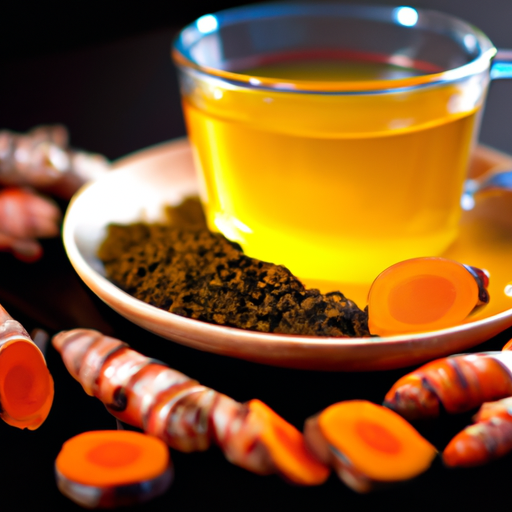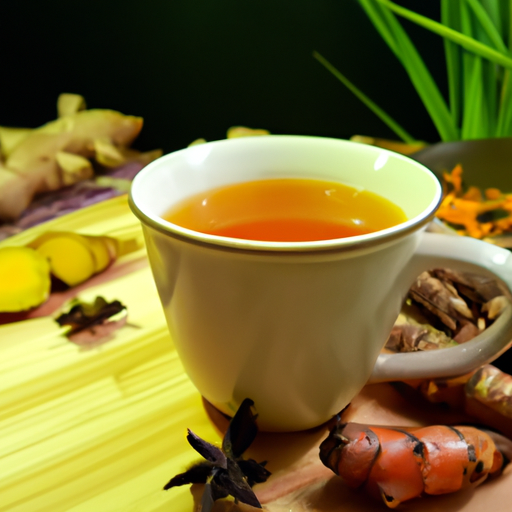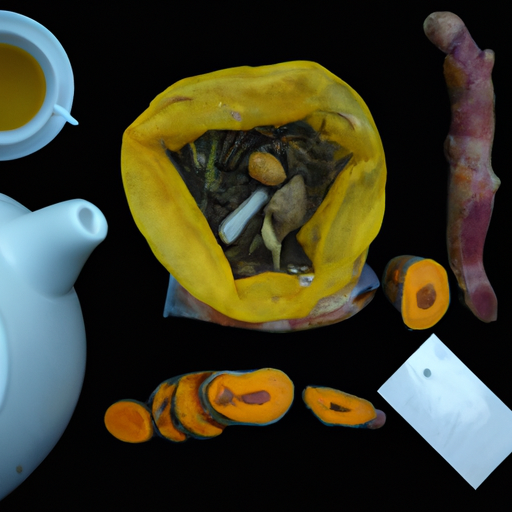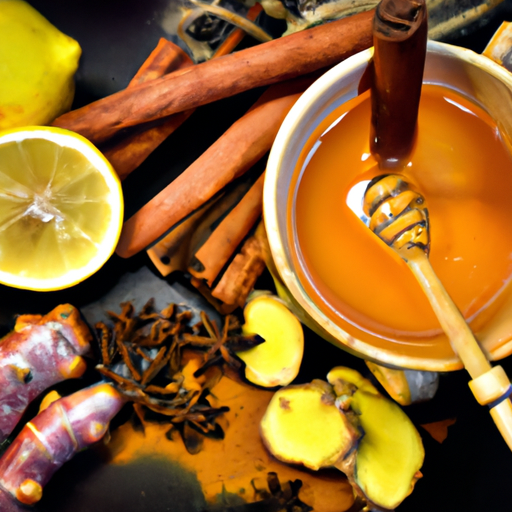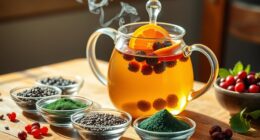I enjoy drinking turmeric tea because of its many health benefits, however, I used to have trouble making a cup that wasn’t chalky or grainy. It took me some time to discover the correct ingredients and methods of preparation, but now I can proudly say that I am able to consistently make a tasty and silky smooth cup of turmeric tea every time.
In this article, I’ll share my tips on how to make turmeric tea that isn’t powdery. We’ll start by discussing the challenges of making this drink and then move on to choosing the right ingredients and preparation techniques.
Additionally, we’ll explore the health benefits of turmeric tea and other ways you can use this versatile spice in your cooking. So grab your favorite mug, and let’s get started!
Key Takeaways
- Use fresh or whole turmeric root for a deeper flavor and aroma
- Use a blender or milk frother for a smooth and creamy texture
- Experiment with different flavors to adjust the taste of the tea
- Use black pepper for better absorption of curcumin and keep temperature under 185°F (85°C) for best results
Understanding the Challenges of Making Turmeric Tea
Making turmeric tea can be challenging due to the difficulty in achieving a smooth consistency without leaving any powdery residue. However, the benefits of turmeric tea are plenty, making it a popular beverage choice among health enthusiasts.
Turmeric powder is not water-soluble and tends to clump together when mixed with hot water. To make a perfect cup of turmeric tea that isn’t powdery, you need to choose the right ingredients. There are several recipes available online using fresh or ground turmeric roots, but if you’re new to making this tea at home, I suggest starting with ground turmeric powder as it’s widely available and easy to use.
The key is to whisk the powder thoroughly into boiling water first before adding other ingredients such as milk or honey. By doing so, you’ll get a smooth texture that’s free from any lumps or residues.
Choosing the Right Ingredients
To ensure you have a delicious cup of turmeric tea, it’s important to select the perfect ingredients. Here are some tips on how to choose the right ingredients:
-
Turmeric varieties: There are different types of turmeric available in the market such as fresh turmeric root, dried turmeric powder, and whole turmeric roots. Fresh or whole root is preferred for making tea as it has a deeper flavor and aroma than powdered form.
-
Quality of water: The quality of water used in brewing affects the taste and quality of your tea. It’s best to use filtered or spring water to make sure that there are no impurities that could affect the taste and health benefits.
-
Sweeteners: To enhance the flavor, some people prefer adding honey or stevia to their tea instead of refined sugar.
-
Brewing time: Over-brewing can result in a bitter taste while under-brewing may not bring out all the flavors from spices and herbs properly. A good rule is to steep your tea for 5-10 minutes.
Now that we’ve covered how to choose the right ingredients for your cup of turmeric tea, let’s move onto preparation techniques like simmering or blending!
Preparation Techniques
So now that I’ve got my ingredients ready, it’s time to start preparing my turmeric tea.
There are a few different techniques that I like to use, depending on how I’m feeling and what tools I have available. One of my go-to methods is using a blender – this helps create a smooth and creamy texture that really enhances the flavor of the tea.
Another technique that can be useful is straining the tea through a fine mesh sieve, which removes any leftover bits of ginger or turmeric for an even smoother finish. And if you’re looking to add some frothiness to your tea, using a milk frother can do the trick – just be sure to add in some kind of milk or cream first!
Using a Blender
If you’re feeling lazy, throw those turmeric chunks in a blender for a smooth and hassle-free tea-making experience. Not only does this method save time, but it also ensures that your tea isn’t powdery or gritty. Plus, using a blender allows you to experiment with different flavor variations by adding in other ingredients like ginger, honey, or lemon.
To use the blender method, simply add your desired amount of fresh turmeric chunks (peeled and sliced) into the blender with hot water and any additional ingredients. Blend on high speed for about 30 seconds until everything is well combined and smooth. Then pour the mixture through a fine-mesh strainer to remove any leftover pieces before enjoying your deliciously creamy turmeric tea.
Next up: Straining the Tea…
Straining the Tea
After blending the turmeric and other ingredients, pour the creamy mixture through a fine-mesh strainer to sieve out any leftover chunks or fibers. There are different types of strainers you can use for this process, such as cheesecloth or nut milk bags. However, using a fine-mesh strainer will work just as well in removing any impurities from the tea.
If you do not have a strainer at home, there are still ways to strain your turmeric tea without one. For instance, you can use a coffee filter or even a clean piece of cloth to filter out any large particles before drinking. Whatever method you choose, make sure to take your time when pouring the tea through the strainer so that all the liquid gets filtered out properly. Once your tea is strained and smooth, it’s ready for frothing with a milk frother!
Using a Milk Frother
To achieve a creamy and frothy texture, simply use a milk frother to whisk your strained turmeric mixture until it reaches your desired consistency. This method is perfect for those who want to avoid using powdery turmeric in their tea.
If you don’t have a milk frother on hand, there are alternative ways to create the same effect such as shaking the mixture vigorously in a jar or using an immersion blender.
When it comes to flavor variations, adding honey or maple syrup can sweeten up the tea while adding ginger or cinnamon can give it an extra kick of spice. Experimenting with different flavors will not only make your tea more enjoyable but also provide additional health benefits.
Now that we’ve covered how to achieve that creamy texture using a milk frother or alternative methods, let’s move on to discussing whether boiling or simmering is best for making turmeric tea.
Boiling vs. Simmering
When it comes to making turmeric tea, there are two main methods: boiling and simmering. Each method has its advantages and disadvantages, depending on the desired outcome.
Boiling is great for extracting the maximum amount of flavor and nutrients from the ingredients, but it can also result in a strong and bitter taste. Simmering, on the other hand, is gentler and produces a milder flavor, but it may not fully extract all the beneficial compounds.
Choosing the right temperature for your preparation method is key to achieving your desired taste and health benefits.
Advantages and Disadvantages of Each Method
Deciding which method to use for making turmeric tea can be overwhelming, but knowing the pros and cons of each can help you find the perfect balance. Boiling requires bringing water to a rolling boil before adding the turmeric, while simmering involves heating water to just below boiling point and then adding the spice.
Here are some advantages and disadvantages of each method:
- Boiling can extract more flavor from the turmeric, resulting in a stronger taste.
- Simmering allows for slower extraction of flavor, resulting in a milder taste.
- Boiling may cause some loss of nutrients due to longer exposure to high heat.
- Simmering is gentler on the nutrients and may preserve them better.
- Boiling may result in a cloudier tea due to more agitation.
Considering these factors, it’s up to personal preference which method to choose. However, if you want maximum benefits from your turmeric tea without sacrificing too much on flavor or clarity, simmering is most likely your best bet.
When making turmeric tea, choosing the right temperature is also important.
Choosing the Right Temperature
You don’t want to ruin the health benefits of your turmeric tea by using water that’s too hot or too cold. It’s important to choose the right temperature for brewing your tea, as it can affect both the flavor and the nutritional benefits you’ll receive. Here are some benefits of different tea temperatures to keep in mind when making your turmeric tea:
| Temperature | Benefits |
|---|---|
| 160°F-170°F (71°C-77°C) | Ideal for preserving antioxidants and other beneficial compounds in the turmeric. |
| 175°F-185°F (79°C-85°C) | Enhances the flavor profile of turmeric and allows for better extraction of its essential oils. |
Remember that higher temperatures can destroy beneficial compounds in spices like turmeric, so it’s best to keep it under 185°F (85°C). However, if you prefer a stronger flavor, slightly higher temperatures may be suitable for you.
How temperature affects tea flavor is another factor to consider when brewing your turmeric tea. Lower temperatures tend to produce a smoother, sweeter taste with less bitterness, while higher temperatures extract more tannins from the leaves and can result in a more bitter flavor. Keep these tips in mind as you experiment with different brewing methods for your perfect cup of turmeric tea.
Transitioning into adjusting the recipe: Now that we’ve covered how temperature affects your brew, let’s move on to adjusting the recipe itself for optimal results.
Adjusting the Recipe
To get a smooth and creamy texture for your turmeric tea, it’s important to blend fresh turmeric root with hot water and other ingredients. Here are some recipe variations and flavor combinations you can try to adjust the taste of your tea:
- Add ginger or cinnamon for a spicy kick.
- Use coconut milk or almond milk instead of regular milk for a creamier texture.
Experimenting with different flavors is key to finding the perfect recipe that suits your taste buds. Remember, there’s no one right way to make turmeric tea, so don’t be afraid to try new things.
Now that you’ve made a delicious cup of turmeric tea, it’s important to know how to properly store and reheat it.
Storing and Reheating
When storing and reheating your turmeric tea, it’s important to remember that it should be kept in an airtight container in the refrigerator for up to three days. This will help preserve the freshness of the tea and prevent any bacteria growth. Make sure to label the container with the date you made the tea so that you know when it needs to be consumed by.
To reheat your turmeric tea, simply heat it up on the stove or in the microwave until warm. However, avoid boiling or overheating as this could destroy some of its beneficial compounds. If you prefer your tea cold, pour it over ice instead of reheating.
By following these simple storing tips and reheating methods, you can enjoy your delicious and healthy turmeric tea anytime! Now let’s move onto learning about the amazing health benefits of turmeric tea.
Health Benefits of Turmeric Tea
Now that you know how to store and reheat your turmeric tea properly, let’s talk about the health benefits of this delicious drink. Turmeric is a powerful antioxidant and anti-inflammatory agent, thanks to its active ingredient called curcumin. Studies have shown that drinking turmeric tea regularly can help reduce inflammation in the body, which may lead to various chronic diseases such as heart disease, diabetes, and cancer.
But how do you make the perfect cup of turmeric tea? Don’t worry; it’s not as complicated as it sounds. There are many different turmeric tea recipes out there, but here are some brewing tips that work for me:
| Column 1 | Column 2 | Column 3 | Column 4 | Column 5 |
|---|---|---|---|---|
| Use fresh ingredients | Boil water before adding ingredients | Add black pepper for better absorption of curcumin | Steep for at least 10 minutes for maximum flavor and health benefits | Add honey or lemon juice for taste |
By following these tips, you can ensure that your turmeric tea isn’t powdery and has all the health benefits you’re looking for. So grab a mug and start brewing!
Turmeric isn’t just great for making tea; it also has many other uses in cooking and skincare. But before we dive into those topics, let’s first explore some delicious recipes using turmeric!
Other Uses of Turmeric
I’m excited to explore the other uses of turmeric beyond its health benefits in tea. Did you know that turmeric is a staple spice in many cuisines, adding flavor and color to dishes like curries, rice, and soups?
It’s also been used for centuries in traditional medicine for its anti-inflammatory properties and ability to improve digestion. Let’s dive into the culinary and medicinal uses of this versatile spice!
Culinary Uses
For those looking to add a little spice to their beverages, turmeric can be used to create a warm and flavorful tea. Here are three ways to incorporate turmeric into your tea-making routine:
-
Add freshly grated or sliced turmeric root to hot water and let it steep for several minutes before adding honey, lemon, or ginger for additional flavor.
-
Mix ground turmeric with other warming spices such as cinnamon, cardamom, and black pepper for a chai-inspired blend.
-
Make a golden milk latte by combining turmeric powder with coconut milk and sweetening with maple syrup or honey. This creamy beverage is not only delicious but also provides anti-inflammatory benefits thanks to the curcumin found in turmeric.
Turmeric’s flavor is an essential component of many cultural cuisines, including Indian and Southeast Asian dishes. In addition to its culinary uses, this vibrant yellow spice has been used medicinally for centuries due to its potential health benefits such as reducing inflammation and boosting cognitive function.
Medicinal Uses
Utilizing the potential health benefits of turmeric, it has been used medicinally for centuries, particularly for reducing inflammation and improving cognitive function. One way to incorporate turmeric into your daily routine is by making turmeric tea. There are many different recipes available online, but one simple recipe involves boiling water with fresh or ground turmeric and adding honey or lemon for taste. Some people also like to add ginger or black pepper to enhance the flavor and increase the absorption of curcumin, the active ingredient in turmeric.
Turmeric tea benefits include its anti-inflammatory properties, which can help alleviate symptoms of arthritis, osteoarthritis, and other inflammatory conditions. It may also improve brain function and reduce the risk of Alzheimer’s disease by increasing levels of brain-derived neurotrophic factor (BDNF). Additionally, drinking turmeric tea regularly may lower blood sugar levels and reduce the risk of heart disease by improving cholesterol levels. Overall, incorporating this healthy beverage into your daily routine is a great way to reap all the medicinal benefits that turmeric has to offer.
When it comes to purchasing turmeric for making tea or cooking with it in general, there are several options available. Some grocery stores carry fresh or dried turmeric root in their produce section. You can also find ground turmeric in most spice aisles at any supermarket. Alternatively, you can purchase organic powdered turmeric from natural food stores or online retailers such as Amazon.com.
Where to Buy Turmeric
When you’re ready to make your turmeric tea, head to your local grocery store or health food store to pick up some fresh turmeric root. It’s important to use fresh turmeric root for this recipe as the powder can leave a powdery taste and texture in the finished tea.
Here are some tips on where to find fresh turmeric:
- Check your local farmers’ market for vendors selling fresh produce
- Look for Asian markets or specialty stores that carry a variety of spices
- Visit online retailers such as Amazon or Thrive Market for organic options
- Ask your local health food store if they carry fresh turmeric root
- Consider growing your own turmeric plant at home
Fresh turmeric can be stored in the refrigerator for up to 2 weeks. When selecting your roots, look for ones that are firm and free from any soft spots or mold growth.
Incorporating fresh ingredients into our diets is an important part of maintaining good health. By using fresh turmeric root, we can ensure that we’re getting all of its beneficial properties without any unwanted additives or preservatives. Try incorporating some freshly grated turmeric into your next batch of tea and see how it adds a healthy boost!
Frequently Asked Questions
How long does it take to make a cup of turmeric tea?
Quick brewing techniques for turmeric tea can take as little as 5 minutes. Drinking turmeric tea before bed has been linked to improved sleep quality and reduced inflammation.
Is it possible to add milk or cream to turmeric tea?
Yes, it’s possible to add milk alternatives like almond or coconut milk to turmeric tea. Frothing techniques can create a creamy texture without dairy. Adding milk can also increase absorption of curcumin, the active compound in turmeric.
Can I use ground turmeric instead of fresh turmeric root?
Ground vs fresh: which turmeric is better for tea? While fresh turmeric root may be more flavorful, ground turmeric offers convenience and consistent potency. Both options provide the same beneficial compounds for turmeric tea.
What are some common mistakes people make when making turmeric tea?
Common mistakes when making turmeric tea include using too much turmeric, not properly brewing the tea for long enough, and adding sweeteners that may negate the health benefits. Proper brewing techniques involve simmering fresh or ground turmeric with black pepper and a fat source.
Are there any potential side effects or risks associated with drinking turmeric tea?
Before delving into risks associated with turmeric tea, note its benefits. Turmeric is anti-inflammatory and antioxidant-rich. Safe dosages vary by individual, but a common recommendation is no more than 500 mg per day in supplement form.
Conclusion
In conclusion, making a delicious and healthy cup of turmeric tea isn’t as difficult as it may seem. By understanding the challenges, choosing the right ingredients, using proper preparation techniques, adjusting the recipe to your liking, and storing it correctly, you can enjoy a satisfying cup of turmeric tea that isn’t powdery.
Turmeric has many health benefits, including reducing inflammation and boosting immunity. It’s also versatile and can be used in various dishes, such as curries or smoothies. So why not incorporate this golden spice into your daily routine?
With these tips in mind, go forth and brew yourself a warm cup of turmeric tea for a cozy and beneficial experience.

